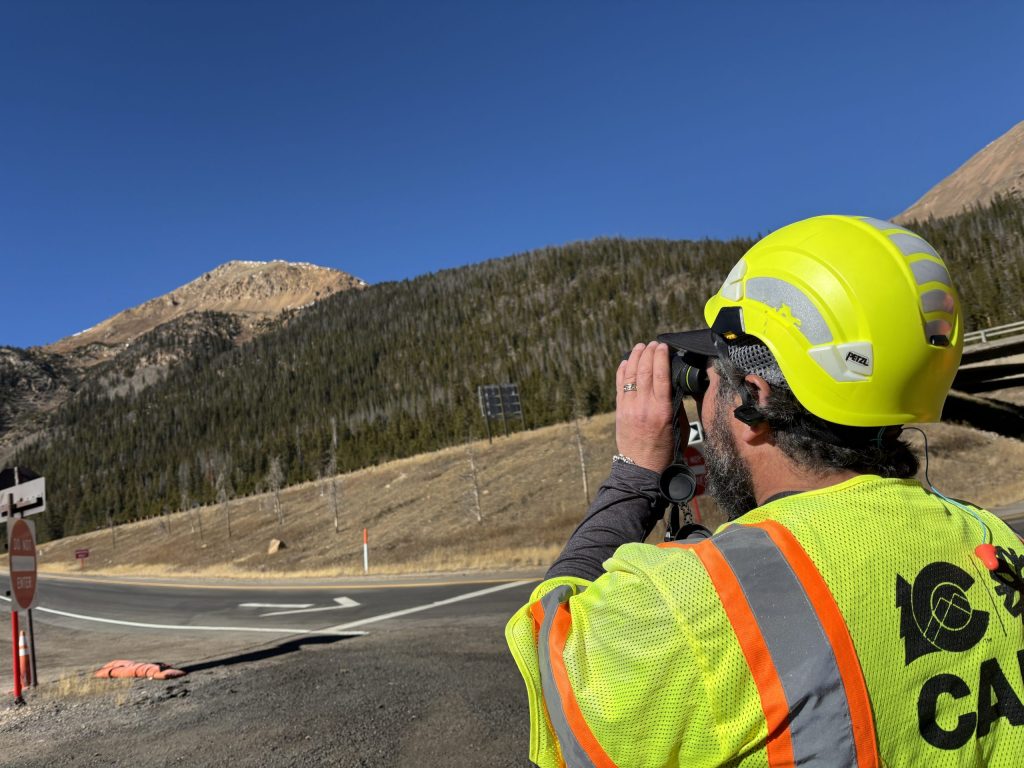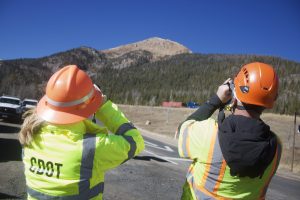WATCH: With new remote systems, CDOT retires use of World War II artillery for avalanche mitigation on I-70
The new Wyssen Avalanche Control system on Mount Bethel uses 11-pound explosives that dangle from a string above the snow

Ryan Spencer/The Aspen Times
Everything was silent on the Interstate 70 corridor for a moment Wednesday afternoon as the Colorado Department of Transportation held traffic a few miles east of the Eisenhower-Johnson Memorial Tunnels.
Then — Boom! — an explosion rang out from high up on Mount Bethel, a prominent 12,705-foot peak with a large avalanche path that slopes toward the interstate.
“There’s a lot of big avalanche paths along the corridor,” Colorado Avalanche Information Center director Ethan Greene said, peering at Mount Bethel through binoculars. “Most of them don’t impact the road very often, but there’s a few that have the potential to have a pretty big impact — and this is one of them.”
There are more than 522 known avalanche paths lining Colorado highways. Every winter, CDOT works with the CAIC to regularly monitor and control about 278 of those avalanche paths.
The avalanche paths on the roughly 3 miles of I-70 on either side of the tunnels are some of the most challenging to maintain because of the steep, snowy terrain along the Continental Divide and the heavy traffic on the I-70 corridor.
The test of the new remote avalanche system on Mount Bethel Wednesday marked the end of an era in Colorado’s Northern Mountains and the I-70 mountain corridor.
“This technology represents a major advancement in how we keep I-70 open and safe during Colorado’s harsh winter storms,” CDOT avalanche program manager Brian Gorsage said. “Remote Avalanche Control Systems allow our teams to work more safely, more efficiently and with far less disruption to drivers traveling this critical mountain corridor.”
For decades, CDOT has maintained slide paths like those on Mount Bethel using a World War II-era artillery weapon known as the M101 Howitzer. But with the installation of a new Wyssen Avalanche Control system on Mount Bethel, this season will be the first where the Howitzer isn’t used along I-70.
That’s good news for drivers headed to the ski mountains this winter because it means shorter and less disruptive closures for avalanche mitigation near the tunnels.

“The new technology really makes the whole program more nimble,” Greene said. “The goal of all of this is to keep traffic moving, so the less we can do to impact that, the better. This gives us more options in terms of the time of day we can do things and gives us more tools to keep traffic moving.”
With the Howitzer, CDOT used to have to wait until morning to conduct avalanche mitigation at Mount Bethel, Gorsage said. But with the new Wyssen system, he said transportation officials will now be able to conduct avalanche mitigation in the early-morning hours, before the sun rises and before ski traffic starts stacking up on the highway.
“This project is exciting because we could only shoot artillery in the daylight hours. That’s like peak ski traffic hours,” Gorsage said. “Now, we’ll do this work well before that — probably like 4 to 4:30 in the morning.”

Artillery weapons like the Howitzer have been used in avalanche mitigation across the mountain West since the 10th Mountain Division, a light infantry division that specialized in winter warfare during World War II, brought the techniques back from Europe, Gorsage said. CDOT has leased the artillery equipment, which will continue to be used in the San Juan Mountains, from the U.S. Army.
But Gorsage said the Army has encouraged transportation departments to phase out use of artillery in favor of remote avalanche control systems. The Wyssen system is one of four different remote avalanche control technologies CDOT has installed in the mountains.
The Wyssen system on Mount Bethel includes three towers. On Wednesday, a helicopter pilot carefully lowered what “deployment boxes” full of explosive charges onto each of these towers. Gorsage described the boxes as essentially “like the inside of a revolver.”

The system works by releasing an 11-pound explosive from the tower on a string so that it hangs just above the snow, where Gorsage said the explosive charge will have a large area of influence.
“It’s got a massive bang,” he said. “We’re putting them right in the money spots.”
While the new Wyssen system should make avalanche mitigation on the I-70 corridor smoother, Gorsage noted that it is still possible that drivers may encounter traffic holds for avalanche mitigation or other winter maintenance.
“We try to do our work when it’s least impactful to traffic, but that doesn’t always happen because we need to shoot when the timing is right,” he said. “So bear with us. We’re just trying to make sure everybody can get from Point A to Point B as safely as possible.”

Missing woman found in Pitkin County
After a woman was reported missing Tuesday, Pitkin County Sheriff’s Office has confirmed she has been found.







